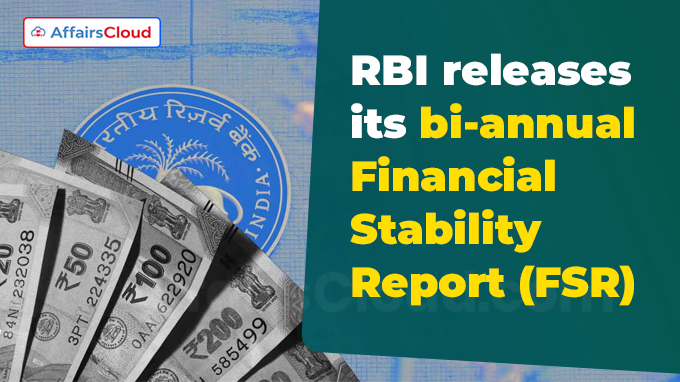 In June 2025, the Reserve Bank of India (RBI) released the half-yearly publication of the ‘Financial Stability Report, June 2025’, which presents the collective assessment of the Sub Committee of the Financial Stability and Development Council (FSDC) on current and emerging risks to the stability of the Indian financial system.
In June 2025, the Reserve Bank of India (RBI) released the half-yearly publication of the ‘Financial Stability Report, June 2025’, which presents the collective assessment of the Sub Committee of the Financial Stability and Development Council (FSDC) on current and emerging risks to the stability of the Indian financial system.
- The report highlighted that the domestic financial system is continuously improving, supported by strong capital buffers, low Non-Performing Loans (NPA) and robust profitability.
Indian economy remains key driver of global growth
i.The Indian economy, supported by strong macroeconomic fundamentals, remained the fastest growing major economy in the world during 2024-25.
- This growth was largely insulated from external shocks, mainly due to major dependence on domestic demand.
ii.The RBI has projected that real Gross Domestic Product (GDP) to grow at 6.5% in Financial Year 2025-26 (FY26), same as in FY25.
iii.The domestic inflation has been steadily declining with the headline consumer price index (CPI) inflation recording a six-year low of 2.8% in May 2025.
- Given this downward trend, achieving the 4% inflation target for the year appears well within reach.
iv.As on June 20,2025, the foreign exchange reserves stood at USD 697.9 billion(bn) sufficient enough to cover more than 11 months of merchandise imports.
Corporate bond market saw record issuances in FY25
i.Corporate bond is a debt instrument issued by the companies to raise money from the investors. These bonds are assigned a credit rating by rating agencies to indicate the creditworthiness of the issuer.
- The corporate bond net outstanding rose to Rs.53.6 lakh crore as at end March 2025 with the highest ever fresh issuance of Rs.9.9 lakh crore during 2024-25.
- In 2024-25, AAA-rated firms dominated issuances with firms rated below AA constituting 16.0% of the total issuances.
NBFCs’ share of stressed assets rose to 5.9% in March
i.The share of stressed assets of Non-Banking Financial Company (NBFCs) (including NBFC-Micro Finance Institutions (MFI)) increased from 3.9% in September 2024 to 5.9% in March 2025.
ii.The write-offs for upper layer NBFCs increased to 72.9% in March 2025 from about 50% in June 2022.
- While for middle layer NBFCs, write-offs increased to 38.7% from approximately 20% during the same period.
- As a result, combined write-offs for both layers rose to 46.4% in March 2025.
iii.NBFCs, including housing finance companies (HFCs), and fintech firms account for 84.3% of personal loans below Rs. 50,000.
Bank GNPAs fall to multi-decade low of 2.3% in March
i.The Gross NPA and Net NPA of Scheduled Commercial Banks (SCB) declined to multi-decadal lows of 2.3% and 0.5%, respectively. While in September 2024, the GNPA stood at 2.6%.
ii.As per the macro tests conducted by the RBI, the GNPAs of the 46 banks may marginally rise to 2.5% in March 2027, to 5.6% and 5.3%, under adverse scenario 1 and adverse scenario 2, respectively.
iii.With respect to Sector-wise GNPA, agriculture had the highest contribution to GNPA at 6.1% and on the other hand Personal loan at 1.2%.
- However, public sector banks’ GNPAs from the credit card segment moved up to 14.3% as against 2.1% in the case of the private sector banks.
iv.While the share of the large borrowers in the GNPAs was 37.5 % as compared to their 43.9% share in the overall outstanding loans.
- The report also highlighted that none of the top 100 borrowers were classified as NPA.
v.Aggregate capital to risk-weighted assets ratio (CRAR) of 46 major SCBs may marginally dip to 17 per cent by March 2027 from 17.2 per cent in March 2025, under the baseline scenario. It may decline to 14.2 per cent under adverse scenario 1, and to 14.6 per cent under adverse scenario 2.
vi.The common equity tier 1 (CET1) capital ratio of the select 46 banks may rise from 14.6 per cent in March 2025 to 15.2 per cent by March 2027 under the baseline scenario. However, it may fall to 12.5 per cent under adverse scenario 1, and to 12.9 per cent under adverse scenario 2.
Writeoffs major factor for lower NPAs in past 5 years
i.Loan write-offs were a major reason for the massive reduction in NPAs ratio over the past five years.
- The write-offs to GNPA ratio for SCBs moved up marginally to 31.8% in 2024- 25 from 29.5% in the previous year, led by Private Banks (PVBs) and Foreign Banks (FB).
- While write-offs by Public Sector Banks (PSBs) exhibited a marginal decline.
ii.The write-offs by private lenders stood at 81.9% in FY25, while those by PSBs accounted for 10.9% in the unsecured retail loan segment.
Borrower indebtedness in microfinance declines to 11.7%
i.The banking sector saw an increase in stress in their microfinance loan book with 31-180 dpd (days past due) rising from 4.7% in September 2024 to 6.5% in March 2025.
- However, borrower indebtedness, measured by the share of borrowers availing loans from three or more lenders, declined to 11.7% in March 2025.
About Financial Stability Report:
i.This is a biannual report released by the RBI in June and December.
- The report is prepared by the Financial Stability Unit(FSU) and is a joint evaluation by the Sub-committee of the FSDC.
- The RBI published its first FSR in 2010.
ii.The report takes inputs from the financial sector regulators i.e. RBI, Securities Exchange Board of India (SEBI), Insurance Regulatory and Development Authority of India (IRDAI), Pension Fund Regulatory and Development Authority (PFRDA) and Ministry of Finance (MoF).
iii.The report covers both international and domestic economic conditions, the performance of Scheduled Commercial Banks (SCBs) and Non-Banking Financial Companies (NBFCs) and the solvency of the insurance sector.
About Financial Stability and Development Council (FSDC):
i.The FSDC is a non-statutory apex council under the Ministry of Finance (MoF). The council is chaired by the Finance Minister.
ii.The Raghuram Rajan Committee (2008) on financial sector reforms had first proposed setting up of FSDC.
About Reserve Bank of India:
Governor – Sanjay Malhotra
Headquarters – Mumbai, Maharashtra
Established – 1 April, 1935




